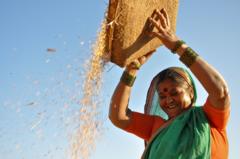As President Trump intensifies trade negotiations, India faces pressure to open its agricultural market, but its own domestic policies and concerns for farmers make such changes unlikely.
Trump's Push for Indian Corn Purchases Faces Significant Hurdles

Trump's Push for Indian Corn Purchases Faces Significant Hurdles
U.S. Secretary of Commerce challenges India’s agricultural trade stance amid a soaring trade conflict.
India’s agricultural landscape is vibrant yet complex, with the country having evolved from a food-scarce nation into a significant agricultural exporter. However, despite this transformation, challenges remain that hinder foreign imports, particularly from the U.S.
India's journey in agriculture, from scarcity to surplus, has been commendable, making it a key player in global food production. Recently, U.S. Commerce Secretary, Howard Lutnick, questioned why India has not yet embraced U.S. corn exports, critiquing its restrictive trade policies. Lutnick's comments come at a time of escalating trade tensions between the two nations, fueled by U.S. accusations of India being overly protective with its agricultural market.
For many years, the United States has sought increased access to India’s agricultural sector, viewing it as a potential goldmine. However, India has consistently prioritized food security and the livelihoods of its smallholder farmers. With the agricultural sector supporting nearly half of its population, India’s refusal to lower import tariffs reflects deep-seated domestic considerations.
Historically, India has maintained high tariffs ranging from moderate to significant, intended to protect local farmers from cheaper international products. While the weighted average tariff on U.S. agricultural imports to India appears high at around 37.7%, the U.S. imposes a mere 5.3% on Indian goods. As bilateral agricultural trade sits at approximately $8 billion, with most exports consisting of rice and shrimp from India and nuts and fruits from the U.S., any push for significant changes requires navigating vast differences in agricultural practices between the two nations.
American farming is characterized by commercial practices buoyed by substantial government subsidies, often exceeding production costs. Meanwhile, Indian agriculture heavily relies on subsistence and small-scale farming, where the average landholding is about one hectare compared to over 46 hectares in the U.S. This disparity contributes to persistently low productivity, hampering potential growth.
Moreover, trade negotiations complicate matters, as India’s agriculture sector has long faced underfunding and struggles with infrastructure and market access. Consequently, Indian farmers have voiced discontent regarding fair pricing and government support, as seen in protests over inadequate price guarantees in recent years.
Experts suggest that India should prioritize protecting its agricultural sector rather than succumbing to external pressures. The warning is clear: opening up agriculture too quickly to foreign imports risks destabilizing local farmers, threatening food security, and undermining India's rural economy.
To move forward effectively, India must find a balance in trade negotiations, focusing on both its agricultural interests and the demands of the U.S. However, modernizing agriculture and improving competitiveness remain essential for India to boost exports and secure its interests on the international stage.
For now, the approach may involve negotiating alternative concessions with the U.S., while firmly safeguarding its agriculture. The outcome of these discussions will all depend on India's ability to maintain its priorities in a challenging global trade landscape, while also addressing domestic agricultural reforms and investments. The clock is ticking, and the stakes are high.
India's journey in agriculture, from scarcity to surplus, has been commendable, making it a key player in global food production. Recently, U.S. Commerce Secretary, Howard Lutnick, questioned why India has not yet embraced U.S. corn exports, critiquing its restrictive trade policies. Lutnick's comments come at a time of escalating trade tensions between the two nations, fueled by U.S. accusations of India being overly protective with its agricultural market.
For many years, the United States has sought increased access to India’s agricultural sector, viewing it as a potential goldmine. However, India has consistently prioritized food security and the livelihoods of its smallholder farmers. With the agricultural sector supporting nearly half of its population, India’s refusal to lower import tariffs reflects deep-seated domestic considerations.
Historically, India has maintained high tariffs ranging from moderate to significant, intended to protect local farmers from cheaper international products. While the weighted average tariff on U.S. agricultural imports to India appears high at around 37.7%, the U.S. imposes a mere 5.3% on Indian goods. As bilateral agricultural trade sits at approximately $8 billion, with most exports consisting of rice and shrimp from India and nuts and fruits from the U.S., any push for significant changes requires navigating vast differences in agricultural practices between the two nations.
American farming is characterized by commercial practices buoyed by substantial government subsidies, often exceeding production costs. Meanwhile, Indian agriculture heavily relies on subsistence and small-scale farming, where the average landholding is about one hectare compared to over 46 hectares in the U.S. This disparity contributes to persistently low productivity, hampering potential growth.
Moreover, trade negotiations complicate matters, as India’s agriculture sector has long faced underfunding and struggles with infrastructure and market access. Consequently, Indian farmers have voiced discontent regarding fair pricing and government support, as seen in protests over inadequate price guarantees in recent years.
Experts suggest that India should prioritize protecting its agricultural sector rather than succumbing to external pressures. The warning is clear: opening up agriculture too quickly to foreign imports risks destabilizing local farmers, threatening food security, and undermining India's rural economy.
To move forward effectively, India must find a balance in trade negotiations, focusing on both its agricultural interests and the demands of the U.S. However, modernizing agriculture and improving competitiveness remain essential for India to boost exports and secure its interests on the international stage.
For now, the approach may involve negotiating alternative concessions with the U.S., while firmly safeguarding its agriculture. The outcome of these discussions will all depend on India's ability to maintain its priorities in a challenging global trade landscape, while also addressing domestic agricultural reforms and investments. The clock is ticking, and the stakes are high.






















